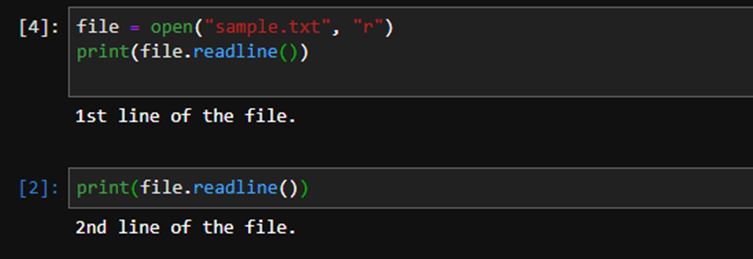
It lists data and data subscripts simultaneously, which will be used in the for loop as in the above example. The enumerate() function is used to combine an iterable data object (such as a list, tuple, or string) into an index sequence. In this case, we might use enumerate(): with open("file.txt") as f: When reading files, a large one may cause problems such as won’t fit into memory. enumerate During Reading Specific Lines From a Large File in Python The traceback module uses it to retrieve the source lines contained in the formatted traceback. The linecache module allows you to get any line from a python source file while using the cache to optimize internally, which is a common practice of reading many lines from a single file. The string method strip() returns a string that strips white spaces from both ends. The linecache module could be used for reading many files, possible repeatedly or extracting many lines: import linecacheĭata = linecache.getline('file.txt', 10).strip() The linecache Module to Read the Specific Lines in Python Reading and Writing To Files in Python (Video 41) lines = The for Loop in fileobject to Read Specific Lines in Pythonįor line in fileobject is also a quick solution for small files. If we need to read lines from 10 to 100, with open("file.txt") as f: If we only need to read line 10, with open("file.txt") as f: It could use list slicing to read the specific lines. fileobject.readlines() to Read Specific Lines for Small-Size Fileįileobject.readlines() reads all the file content to the memory. Python has 3 built-in methods to read the specific lines from a file, as introduced in the next sections. But if the file size exceeds 100 MB, it would cause memory issues when it is read into memory. Reading a file in Python is fast for example, it takes roughly 0.67 seconds to write a 100MiB file. enumerate During Reading Specific Lines From a Large File in PythonĪ common way to read a file in Python is to read it entirely and then process the specific line.the linecache Module to Read the Specific Lines in Python.the for Loop in fileobject to Read Specific Lines in Python.fileobject.readlines() to Read Specific Lines for Small-Size File.Print(linecache.getline('this_is_file.Created: March-02, 2020 | Updated: October-17, 2021 Now, suppose you are told to read the line no 7 from the text file. Thankfully Python has linecache module which allows us to get any particular line from any file. I love Python just because of its cool built-in modules. Output: I am line no 5 Read a specific line from a text file in Python using linecache module

Then we will use the below code: file = open('this_is_file.txt')

Now we have to read the texts from line no 5. Here is the content of the text file: I am line no 1
#Readlines izip python how to
How to count the number of lines in a text file in Python.In my previous Python tutorials, I have shown you several things you can do with a text file like We can achieve the line reading in Python with several methods but we will show you the easiest method first. An empty string is returned only when EOF is.


If the optional sizehint argument is present, instead of reading up to EOF, whole lines totalling approximately sizehint bytes (possibly after rounding up to an internal buffer size) are read. To read a specific line from a text file in Python you can use readlines() or you can also import linecache. Here we gonna learn reading a specific line from a text file in Python for both large and small files. The method readlines () reads until EOF using readline () and returns a list containing the lines.


 0 kommentar(er)
0 kommentar(er)
